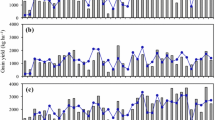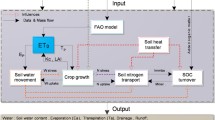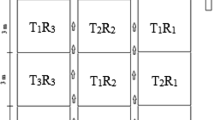Abstract
Crop growth models have been used in simulating the soil water balance for purposes of irrigation management and yield predictions. The application of CropSyst, a cropping systems simulation model, was evaluated for Cedara, South Africa. Simulations included soil water balance of fallow land and rainfed and irrigated winter crops [oats (Avena sativa), Italian ryegrass (Lolium multiflorum) and rye (Secale cereale)]; and irrigation scheduling of the winter crops. Soil, plant, weather and management inputs were used for the soil water balance simulations. Model crop parameters were used from past experiments or obtained from model documentation, with a slight modification to account for varietal differences. The fallow land soil water simulations were more accurate for dry than for wet soil. For all three winter crops, the model consistently over-estimated the soil water content in the upper layers, with a good agreement for the deeper layers until a large precipitation event occurred to which the model responded more slowly than that observed. Simulations using model-scheduled irrigation based on 0.4 and 0.6 maximum allowable depletion criteria indicated that the observed applied irrigation in the field was more than that required. Soil water depletion and accumulated transpiration simulations were similar in both the observed and model-scheduled irrigations, but total soil evaporation and percolation were greater in the case of the observed than the model-scheduled irrigations. Irrigation scheduling using crop growth models may assist in avoiding over- or under-application of irrigation applications by ensuring efficient utilization of rain and irrigation.



Similar content being viewed by others
References
Abraha MG, Savage MJ (2006) Potential impacts of climate change on the grain yield of maize for the midlands of KwaZulu-Natal, South Africa. Agric Ecosyst Environ 115:150–160
Allen RG, Pereira LS, Raes D, Smith M (1998) Crop evapotranspiration (guidelines for computing crop water requirements). FAO Irrig Drain Pap No. 56
Annandale JG, Benadé N, van der Westhuizen AJ, Campbell GS (1996) The SWB (soil water balance) irrigation scheduling model. In: Camp CR, Sadler EJ, Yoder RE (eds) Evaporation and irrigation scheduling. Proceedings of the International Conference, San Antonio, TX, 3–6 November 1996. ASAE, pp 944–949
Ångström A (1924) Solar and terrestrial radiation. Q J R Meteorol Soc 50:121–126
Badini O, Stöckle CO, Franz EH (1997) Application of crop simulation modeling and GIS to agroclimatic assessment in Burkina Faso. Agric Ecosyst Environ 64:233–244
Benadé N, Annandale JG, Van Zijl H (1996) The development of a computerized management system for irrigation schemes. Water Research Commission Report, ISBN 1-86845-336-7, Pretoria, South Africa
Campbell GS, Campbell MD (1982) Irrigation scheduling using soil moisture measurements: theory and practice. Adv Irrig 1:25–42
Campbell GS, Stöckle CO (1993) Prediction and simulation of water use in agricultural systems. In: Int Crop Sci I. CSA, Madison, WI, pp 67–73
Donatelli M, Stöckle CO, Ceotto E, Rinaldi M (1996) CropSyst validation for cropping systems at two locations of Northern and Southern Italy. Eur J Agron 6:35–45
Ferrer-Alegre F, Stöckle CO (1999) A model for assessing crop response to salinity. Irrig Sci 19:15–23
Gebregiorgis MF, Savage MJ (2006) Determination of the timing and amount of irrigation of winter cover crops with the use of dielectric constant and capacitance soil water content profile methods. S Afr J Plant Soil 23:145–151
Hill RW (1991) Irrigation scheduling. In: Hanks J, Ritchie JT (eds) Modeling plant and soil systems. Agron Monograph 31, ASA-CSSA-SSSA, Madison, pp 429–509
Hillel D (1990) Role of irrigation in agricultural systems. In: Stewart BA, Nielson DR (eds) Irrigation of agricultural crops. Agron Monograph 30, ASA, Madison, pp 5–29
Jara J, Stöckle CO (1999) Simulation of corn water uptake using models with different levels of process detail. Agron J 91:256–265
Jones JW, Ritchie JT (1990) Crop growth models. In: Hoffman GJ, Howell TA, Solomon KH (eds) Management of farm irrigation systems. An ASAE Monograph. ASAE, St Joseph, pp 63–89
Jovanovic NZ, Annandale JG, Benadé N, Rethman NFG (1999) SWB—a mechanistic water balance-soil salinity model for irrigation with lime-treated acid mine drainage. 17th Cong of the Int Comm Irri Drain, Special Session R.6, Granada, Spain
Lukangu G, Savage MJ, Johnston MA (1999) Use of sub-hourly soil water content measured with a frequency-domain reflectometer to schedule irrigation of cabbages. Irrig Sci 19:7–13
Moodley M, Johnston MA, Hughes JC, Titshall L (2004) Effects of a water treatment residue, lime, gypsum, and polyacrylamide on the water retention and hydraulic conductivity of two contrasting soils under field conditions in KwaZulu-Natal, South Africa. Aust J Soil Res 42:273–282
Pala M, Stöckle CO, Harris HC (1996) Simulation of Durum wheat (Triticum turgidum spp. durum) growth under different water and nitrogen regimes in a Mediterranean environment using CropSyst. Agric Syst 51:147–163
Pannkuk CD, Stöckle CO, Papendick RI (1998) Validation of CropSyst for winter and spring wheat under different tillage and residue management practices in a wheat-fallow region. Agric Syst 57:121–134
Peralta JM, Stöckle CO (2001) Nitrate from an irrigated crop rotation at the Pasco-Quincy area (Washington, USA) available for groundwater contamination: a long-term simulation study. Agric Ecosyst Environ 88:23–34
Phene CJ, Allee CP, Pierro JD (1989) Measurement soil matric potential and real-time irrigation scheduling. Agric Water Manag 16:173–185
Reid PCM (1986) Evaluation of the coefficients of Ångström formula for the estimation of solar radiation in South Africa. S Afr J Plant Soil 3:45–48
Soil Classification Working Group (1991) Soil classification: a taxonomic system for South Africa. The Department of Agricultural Development, Pretoria, South Africa
Stöckle CO, Debaeke P (1997) Modelling crop nitrogen requirements: a critical analysis. Eur J Agron 7:161–169
Stöckle CO, Nelson R (2000) Cropping systems simulation model user’s manual. Biological systems engineering. Washington State University, Pullman
Stöckle CO, Martin S, Campbell GS (1994) CropSyst, a cropping systems model: water/nitrogen budgets and crop yield. Agric Syst 46:335–359
Stöckle CO, Cabelguenne M, Debaeke P (1997) Comparison of CropSyst performance for water management in Southwestern France using submodels of different levels of complexity. Eur J Agron 7:89–98
Stöckle CO, Donatelli M, Nelson R (2003) CropSyst, a cropping systems simulation model. Eur J Agron 18:289–307
Whisler FD, Acock B, Baker DN, Fye RE, Hodges HF, Lambert JR, Lemmon JE, McKinion JM, Reddy VR (1986) Crop simulation models and types of models. Adv Agron 40:141–208
Willmott CJ (1981) On the validation of models. Phys Geogr 2:184–194
Acknowledgments
We thank Ms S. Bezuidenhout and Mr N. van Rij (Crop Protection Section) of the Department of Agriculture and Environmental Affairs, Cedara, South Africa for their assistance and Ms J. Manickum, Mr P. Dovey, Mr Essack Abib and Mr Tad Dorasamy of the University of KwaZulu-Natal for technical assistance. Crop data for oats, ryegrass and rye from the Department of Plant Production and Soil Science, University of Pretoria, South Africa is gratefully acknowledged. Funding from the University of KwaZulu-Natal and the World Bank in Agreement with the Human Resource Development of the University of Asmara, Eritrea for this research is also gratefully acknowledged.
Author information
Authors and Affiliations
Corresponding author
Additional information
Communicated by S.Ortega-Farias.
Rights and permissions
About this article
Cite this article
Abraha, M.G., Savage, M.J. The soil water balance of rainfed and irrigated oats, Italian rye grass and rye using the CropSyst model. Irrig Sci 26, 203–212 (2008). https://doi.org/10.1007/s00271-007-0086-8
Received:
Accepted:
Published:
Issue Date:
DOI: https://doi.org/10.1007/s00271-007-0086-8




